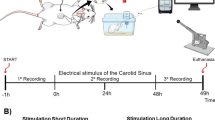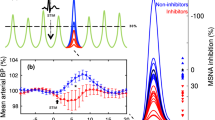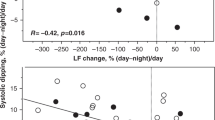Abstract
Targeting the carotid body (CB) is a new approach in treating hypertension. This study investigates the efficacy and safety of ultrasound combined with microbubbles in targeting CB to treat hypertension. Twenty-seven hypertensive rabbits were randomly assigned to three groups: microbubbles only (sham group, n = 11), ultrasound plus microbubbles (LIFU group, n = 11), and bilateral carotid sinus nerve denervation (CSND group, n = 5). Four weeks post-intervention, blood pressure, hypoxic ventilatory response (HVR), blood pressure variability (BPV), heart rate variability (HRV), biochemical indicators, neurohormones, and histopathology were assessed in all groups. The results indicated significant reductions in systolic and diastolic blood pressure in the LIFU and CSND groups post-intervention, along with decreases in BPV, HRV, and catecholamines. HVR results showed a 35.10% reduction in CB activity in the LIFU group compared to the sham group, which was significantly lower than the reduction in the CSND group compared to the sham group (73.85%). Histopathology and transmission electron microscopy confirmed CB damage and cell apoptosis, with immunofluorescence showing a reduction in type I and II cells. In conclusion, LIFU combined with microbubbles can reduce blood pressure by lowering CB and sympathetic nerve activity.

This is a preview of subscription content, access via your institution
Access options
Subscribe to this journal
Receive 12 print issues and online access
269,00 € per year
only 22,42 € per issue
Buy this article
- Purchase on SpringerLink
- Instant access to full article PDF
Prices may be subject to local taxes which are calculated during checkout






Similar content being viewed by others
Data availability
The data for this study are available upon reasonable request to the corresponding author.
References
Sverre EK. Hypertension and cardiovascular risk: General aspects. Pharm Res. 2017;129:95–99.
Victor JD, Celynne AB. Future of Hypertension. Hypertension. 2019;74:450–7.
Roland ES, Christian O, Stefan WT, Peter B, Michael G, Omar D, et al. Phase II randomized sham-controlled study of renal denervation for individuals with uncontrolled hypertension - WAVE IV. J Hypertens. 2017;36:680–9.
Ronald GV. Carotid baroreflex activation therapy for resistant hypertension. Nat Rev Cardiol. 2015;12:451–63.
Fu LN, Manish S, Felix M, Atul P, Melvin DL. Device-based Therapy for Hypertension. Curr Hypertens Rep. 2016;18:61.
Rodrigo I, Julio A, Mark WC, Virend KS. Carotid body chemoreceptors: physiology, pathology, and implications for health and disease. Physiol Rev. 2021;101:1177–235.
Patricia O-S, José L-B. Physiology of the Carotid Body: From Molecules to Disease. Annu Rev Physiol. 2019;82:127–49.
Rodrigo I, Rodrigo DR, Juan I, Virend KS. Carotid body chemoreceptors, sympathetic neural activation, and cardiometabolic disease. Biol Res. 2016;49:13.
Rodrigo DR, David CA, Claudia L, Paulina A, Rodrigo I. Carotid Body Ablation Abrogates Hypertension and Autonomic Alterations Induced by Intermittent Hypoxia in Rats. Hypertension. 2016;68:436–45.
Wioletta P, Pedro LK, Helio CS, Gisele SL, Ruy RC, Fiona DM, et al. Variable role of carotid bodies in cardiovascular responses to exercise, hypoxia and hypercapnia in spontaneously hypertensive rats. J Physiol. 2018;596:3201–16.
Krzysztof N, Laura EKR, Emma CH, Linford JBB, Marzena C, Jacek W, et al. Unilateral Carotid Body Resection in Resistant Hypertension: A Safety and Feasibility Trial. JACC Basic Transl Sci. 2016;1:313–24.
Rodrigo I. Translating carotid body function into clinical medicine. J Physiol. 2017;596:3067–77.
Ando H, Feril L, Kondo T, Tabuchi Y, Ogawa R, Zhao Q, et al. An echo-contrast agent, Levovist, lowers the ultrasound intensity required to induce apoptosis of human leukemia cells. Cancer Lett. 2006;242:37–45.
Kimmel E. Cavitation bioeffects. Crit Rev Biomed Eng. 2006;34:105–61.
Yang S, Tang K, Bai W, Zhao Y, Shen E, Tao J, et al. Combined low-frequency ultrasound and microbubble contrast agent for the treatment of benign prostatic hyperplasia. J Endourol. 2013;27:1020–6.
He J, Liu Z, Zhu X, Xia H, Gao H, Lu J. Ultrasonic Microbubble Cavitation Enhanced Tissue Permeability and Drug Diffusion in Solid Tumor Therapy. Pharmaceutics. 2022;14:1642.
Han Y, Sun J, Wei H, Hao J, Liu W, Wang X. Ultrasound-Targeted Microbubble Destruction: Modulation in the Tumor Microenvironment and Application in Tumor Immunotherapy. Front Immunol. 2022;13:937344.
Qian X, Ruiyu W, Liang W, Bo X, Lingjiao L, Jun Q, et al. Downregulating the P2X3 receptor in the carotid body to reduce blood pressure via acoustic gene delivery in canines. Transl Res. 2020;227:30–41.
Svendsen E, Tindall AR. Raised blood pressure and endothelial cell injury in rabbit aorta. Acta Pathol Microbiol Scand A. 1981;89:325–34.
Judy W, Watanabe A, Henry D, Besch H, Murphy W, Hockel G. Sympathetic nerve activity: role in regulation of blood pressure in the spontaenously hypertensive rat. Circ Res. 1976;38:21–9.
Bencze M, Behuliak M, Zicha J. The impact of four different classes of anesthetics on the mechanisms of blood pressure regulation in normotensive and spontaneously hypertensive rats. Physiological Res. 2013;62:471–8.
Mi-Kyung S, Lenise JK, Candela C-E, Vsevolod YP. Experimental Approach to Examine Leptin Signaling in the Carotid Bodies and its Effects on Control of Breathing. J Vis Exp. 2019, https://doi.org/10.3791/60298)(152).
Koeners M, Lewis K, Ford A, Paton J. Hypertension: a problem of organ blood flow supply-demand mismatch. Future Cardiol. 2016;12:339–49.
Maciej S, Jacek L, Jacek P, Joanna B, Piotr A, Agnieszka C, et al. Tonic activity of carotid body chemoreceptors contributes to the increased sympathetic drive in essential hypertension. Hypertens Res. 2011;35:487–91.
McBryde F, Abdala A, Hendy E, Pijacka W, Marvar P, Moraes D, et al. The carotid body as a putative therapeutic target for the treatment of neurogenic hypertension. Nat Commun. 2013;4:2395.
Kumar P, Prabhakar N. Peripheral chemoreceptors: function and plasticity of the carotid body. Compr Physiol. 2012;2:141–219.
Abdala A, McBryde F, Marina N, Hendy E, Engelman Z, Fudim M, et al. Hypertension is critically dependent on the carotid body input in the spontaneously hypertensive rat. J Physiol. 2012;590:4269–77.
Porzionato A, Macchi V, Stecco C, De Caro R. The Carotid Sinus Nerve-Structure, Function, and Clinical Implications. Anat Rec. 2019;302:575–87.
Dempsey J, Smith C. Pathophysiology of human ventilatory control. Eur Respiratory J. 2014;44:495–512.
Johnson B, Joyner M. Carotid body denervation: too soon to get breathless about heart failure? J Am Coll Cardiol. 2013;62:2431–2.
Pardal R, Ortega-Sáenz P, Durán R, López-Barneo J. Glia-like stem cells sustain physiologic neurogenesis in the adult mammalian carotid body. Cell. 2007;131:364–77.
Bokor D. Diagnostic efficacy of SonoVue. Am J Cardiol. 2000;86:19G–24G.
Morel D, Schwieger I, Hohn L, Terrettaz J, Llull J, Cornioley Y, et al. Human pharmacokinetics and safety evaluation of SonoVue, a new contrast agent for ultrasound imaging. Invest Radio. 2000;35:80–5.
Filippone A, Kirchin M, Monteith J, Storto M, Spinazzi A. Safety of Lumason® (SonoVue®) in special populations and critically ill patients. Front Cardiovasc Med. 2023;10:1225654.
Acknowledgements
We thank the Chongqing Key Laboratory of Ultrasound Molecular Imaging (Chongqing Medical University) for their support. We thank all the members of the laboratory, especially Dr Yang Cao, for their technical assistance in the use of LIFU-mediated ultrasound cavitation.
Funding
The work was supported by National Natural Science Foundation of China (No. 82170445, 81370440 and 81900361), and partly by Major Scientific Instrument Development Project of the National Natural Science Foundation of China (32127802), the National Science-Technology Support Projects of China (No. 2015BAI01B00) and Encouraged Scientific Research Projects of Health Commission of Mianyang City (202248).
Author information
Authors and Affiliations
Contributions
JH conceived and designed the study. WY and XJ performed data analysis as well as wrote the manuscript. WY and XJ performed the experiments and collected the data. ZC, YX, HG helped with ultrasound localization and assessment. CL and XL assisted in the establishment of the animal model. JQ, BX and SR assisted in the improvement of equipment for measuring the response to hypoxic ventilation; GC and QS guided the optimization of carotid body ultrasound intervention methods. FL helped with histopathological examination. All authors read and approved the final manuscript.
Corresponding author
Ethics declarations
Conflict of interest
The authors declare no competing interests.
Ethics approval and consent to participate
This experimental study was approved by the Ethics Committee of the Second Affiliated Hospital of Chongqing Medical University (permit number: (2021)347).
Additional information
Publisher’s note Springer Nature remains neutral with regard to jurisdictional claims in published maps and institutional affiliations.
Supplementary information
Rights and permissions
Springer Nature or its licensor (e.g. a society or other partner) holds exclusive rights to this article under a publishing agreement with the author(s) or other rightsholder(s); author self-archiving of the accepted manuscript version of this article is solely governed by the terms of such publishing agreement and applicable law.
About this article
Cite this article
Jiang, X., Yu, W., Chen, Z. et al. Low-intensity focused ultrasound combined with microbubbles for non-invasive downregulation of rabbit carotid body activity in the treatment of hypertension. Hypertens Res 47, 3182–3192 (2024). https://doi.org/10.1038/s41440-024-01904-3
Received:
Revised:
Accepted:
Published:
Issue Date:
DOI: https://doi.org/10.1038/s41440-024-01904-3



